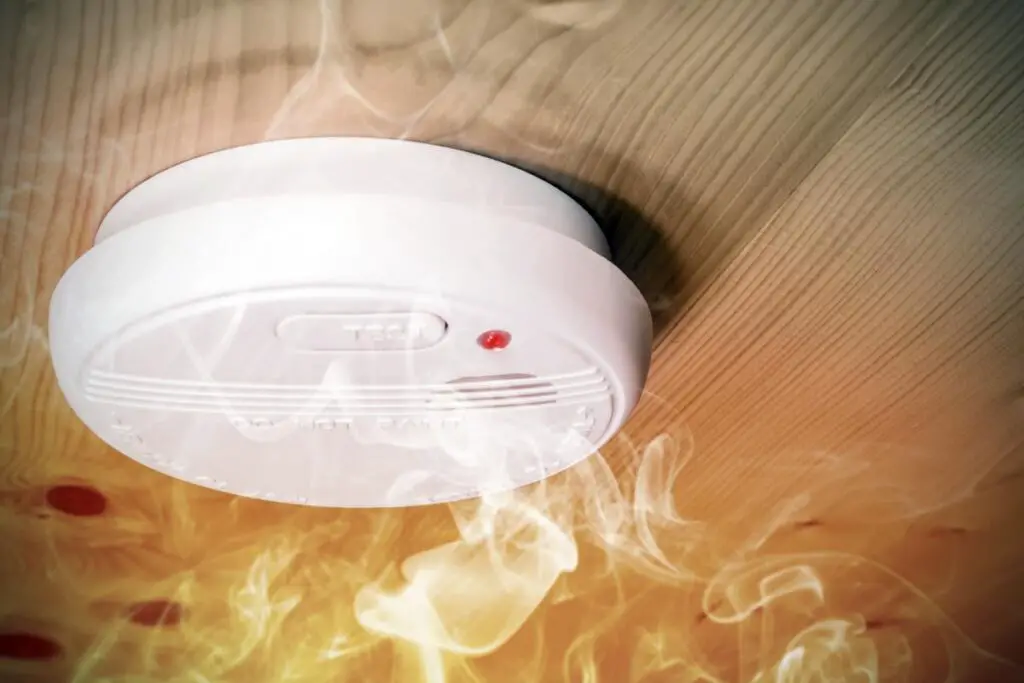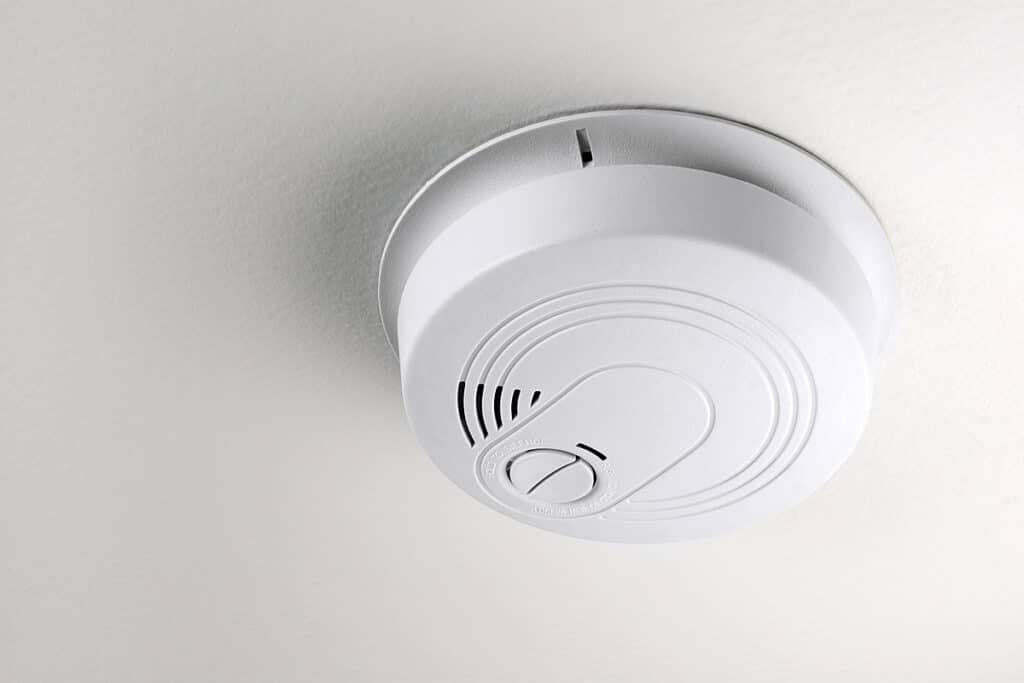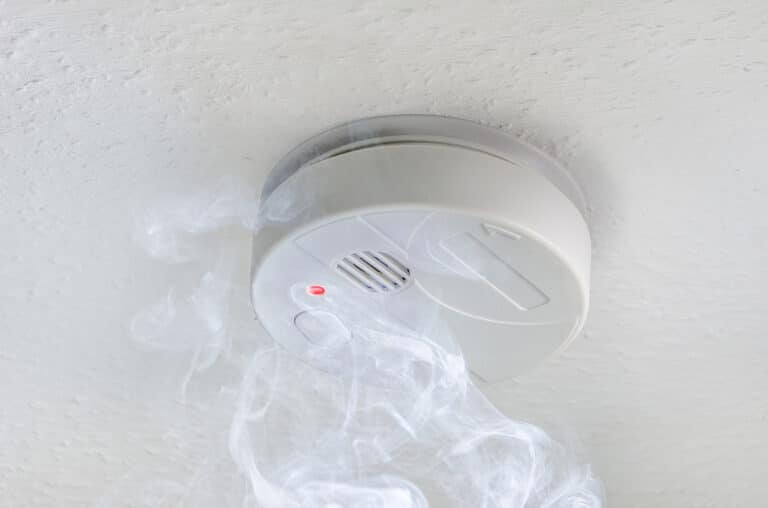Introduction
How To Disconnect Hardwired Smoke Detector: Hardwired smoke detectors are an essential safety feature in any home or building. They are designed to detect hardwired smoke and alert occupants to the presence of a fire, providing valuable time to evacuate and call emergency services. However, there may be instances where you need to disconnect a hardwired smoke detector, such as during renovations or if the detector is malfunctioning. In this article, we will guide you through the process of safely disconnecting a hardwired smoke detector.
Firstly, it is important to note that disconnecting a hardwired smoke detector should only be done if absolutely necessary. These devices are installed for a reason – to protect lives and property. If you are unsure about whether or not you should disconnect a smoke detector, it is always best to consult with a professional electrician or fire safety expert.
Before you begin the process of disconnecting a hardwired smoke detector, it is crucial to ensure your safety. Make sure to turn off the power to the smoke detector circuit at the main electrical panel. This will prevent any risk of electric shock or damage to the detector. Additionally, it is recommended to wear protective gloves and eyewear to protect yourself from any potential hazards.
Once you have taken the necessary safety precautions, you can begin the process of disconnecting the hardwired smoke detector. Start by removing the detector from its mounting bracket. This can usually be done by twisting the detector counterclockwise or by pressing a release button, depending on the model. Once the detector is free from the bracket, carefully disconnect the wires from the back of the detector. It is important to note the color coding of the wires – typically, black is the hot wire, white is the neutral wire, and red is the interconnect wire.

How do I permanently disable my hardwired smoke detector?
Disabling a hardwired smoke detector is not recommended as it compromises the safety of your home. Smoke detectors are essential for early detection of fires and can save lives.
If you need to temporarily disable a hardwired smoke detector, the first step is to locate the main power source. This is usually a circuit breaker or a fuse box. Once you have located the power source, you can turn off the power to the smoke detector by flipping the corresponding switch or removing the fuse. This will disable the smoke detector temporarily, but it is important to remember to turn the power back on once the situation that required the disabling is resolved.
It is important to note that disabling a smoke detector should only be done as a last resort and for a short period of time. Smoke detectors are designed to provide early warning in the event of a fire, and disabling them for an extended period of time can put your home and family at risk. If you are experiencing issues with your smoke detector, it is recommended to contact a professional to inspect and repair the detector.
If you are planning on disabling a smoke detector for an extended period of time, such as during renovations, it is important to consider alternative safety measures. This may include installing temporary smoke detectors in other areas of your home or ensuring that there are working smoke detectors in adjacent rooms. It is also important to have a fire extinguisher readily available in case of emergencies.
Can I cut the wires to my smoke detector?
Smoke detectors are an essential safety feature in any home or building, as they are designed to detect the presence of smoke and alert occupants to the potential danger of a fire.
Smoke detectors are typically hardwired into the electrical system of a building, which ensures that they have a constant power source and are always operational. Cutting the wires to a smoke detector would disconnect it from the power supply, rendering it useless in the event of a fire. This means that if a fire were to occur, you would not receive the early warning that a smoke detector provides, which could be life-saving.
In addition to being hardwired, smoke detectors are often interconnected with other smoke detectors in the building. This means that if one smoke detector detects smoke, it will trigger all the interconnected smoke detectors to sound an alarm. Cutting the wires to a smoke detector could disrupt this interconnection, preventing other smoke detectors from being alerted to the presence of smoke.
Furthermore, tampering with or disabling a smoke detector may be a violation of local building codes and regulations. Many jurisdictions require smoke detectors to be installed and maintained in residential and commercial buildings, and cutting the wires to a smoke detector could result in fines or other penalties.
If you are experiencing issues with your smoke detector, it is best to contact a qualified professional to assess and address the problem. They can determine if the smoke detector needs to be repaired or replaced, and ensure that it is functioning properly to provide the necessary protection in the event of a fire.
Can I unplug smoke detector without turning off breaker?
It is generally not recommended to unplug a smoke detector without turning off the breaker. Smoke detectors are an essential safety feature in any home or building, as they are designed to detect the presence of smoke and alert occupants to potential fires. Unplugging a smoke detector without turning off the breaker can compromise the safety of the building and its occupants.
Smoke detectors are typically hardwired into the electrical system of a building and are connected to a dedicated circuit. This circuit is usually protected by a breaker in the electrical panel. The purpose of the breaker is to prevent overloading of the circuit and to provide a means of disconnecting power to the smoke detector in case of maintenance or emergency situations.
By unplugging a smoke detector without turning off the breaker, you are bypassing this safety mechanism. This can lead to several potential risks. Firstly, if the smoke detector is unplugged while the circuit is still live, it can cause a short circuit or electrical shock hazard. This can be particularly dangerous if the smoke detector is located in a hard-to-reach area, such as a high ceiling or on a staircase.
Secondly, unplugging a smoke detector without turning off the breaker can leave the building vulnerable to fire hazards. Smoke detectors are designed to provide early warning of fires, allowing occupants to evacuate and emergency services to be called. If a smoke detector is unplugged, it will not be able to fulfill its intended function, potentially delaying the detection of a fire and increasing the risk of injury or property damage.
What happens if I unplug smoke detector?
Unplugging a smoke detector can have serious consequences and should never be done intentionally. Smoke detectors are designed to detect the presence of smoke and alert occupants of a building to the potential danger of a fire. They are an essential safety device that can save lives and protect property. Unplugging a smoke detector can disable its ability to detect smoke and sound an alarm, putting the occupants of a building at risk.
When a smoke detector is unplugged, it is no longer able to monitor the air for the presence of smoke. This means that if a fire were to occur, the smoke detector would not be able to detect the smoke and sound an alarm. This can delay the response time of occupants to a fire and increase the risk of injury or death. In addition, an unplugged smoke detector may also disable any interconnected smoke detectors in the building, preventing them from sounding an alarm as well.
It is important to note that smoke detectors are typically hardwired into a building’s electrical system and have a backup battery in case of a power outage. However, even if the smoke detector has a backup battery, unplugging it can still disable its ability to detect smoke. The backup battery is designed to provide power to the smoke detector in the event of a power outage, not when it is intentionally unplugged.
Unplugging a smoke detector may also result in false alarms. Smoke detectors are sensitive devices that can be triggered by things like cooking smoke or steam from a shower. However, these false alarms are a small inconvenience compared to the potential consequences of a fire. It is always better to err on the side of caution and leave the smoke detector plugged in to ensure the safety of the occupants of a building.
How do I temporarily disable my smoke detector?
Temporarily disabling a smoke detector may seem like a convenient solution in certain situations, such as when cooking or having a smoke in a designated area. However, it is important to note that smoke detectors are designed to protect you and your property from potential fire hazards. Disabling them can put you at risk and compromise your safety. Nevertheless, there may be instances where you need to temporarily disable your smoke detector, such as during renovations or when dealing with a false alarm.
Before attempting to disable your smoke detector, it is crucial to understand the potential risks involved. Smoke detectors are essential safety devices that can save lives by alerting occupants to the presence of smoke or fire. By disabling them, you are removing this crucial layer of protection and increasing the likelihood of injury or property damage in the event of a fire.
If you need to temporarily disable your smoke detector, it is important to follow proper procedures to minimize the risks involved. Start by identifying the type of smoke detector you have. There are two main types: battery-operated and hardwired. Battery-operated smoke detectors are typically easier to disable temporarily, as you can simply remove the batteries. However, hardwired smoke detectors are connected to your home’s electrical system and may require additional steps to disable.
If you have a battery-operated smoke detector, follow these steps to temporarily disable it:
1. Locate the smoke detector and remove it from its mounting bracket.
2. Open the battery compartment and remove the batteries.
3. Store the smoke detector and batteries in a safe place until you are ready to reactivate it.
If you have a hardwired smoke detector, follow these steps to temporarily disable it:
1. Locate the circuit breaker or fuse box in your home.
2. Identify the circuit that powers the smoke detector.
3. Switch off the circuit breaker or remove the fuse to cut off power to the smoke detector.
Remember, it is crucial to reactivate your smoke detector as soon as possible to ensure your safety and the safety of your property. If you are unsure about how to disable or reactivate your smoke detector, it is recommended to consult the manufacturer’s instructions or seek assistance from a professional electrician or”
To safely disconnect a hardwired smoke detector, follow these steps:
Step 1: Turn off the power supply to the smoke detector by switching off the circuit breaker or removing the fuse that controls the detector’s circuit.
Step 2: Use a ladder or step stool to reach the smoke detector. Carefully remove the detector from its mounting bracket by twisting it counterclockwise or releasing any locking mechanism.
Step 3: Once the detector is detached from the bracket, locate the wiring connections. There will typically be three wires: black (hot), white (neutral), and green or bare copper (ground).
Step 4: Use a screwdriver or pliers to loosen the wire connectors or screws that secure the wires to the detector. Gently pull the wires apart to disconnect them.
Step 5: After disconnecting the wires, carefully remove the smoke detector from the area, ensuring not to damage any surrounding surfaces or wiring.
By following these steps, you can safely disconnect a hardwired smoke detector.
Are there any specific tools or equipment needed to disconnect a hardwired smoke detector?
When it comes to disconnecting a hardwired smoke detector, there are a few specific tools and equipment that you will need to ensure a safe and successful disconnection. Firstly, you will need a screwdriver, preferably a flathead or Phillips head depending on the type of screws used to secure the detector to the ceiling or wall. This will allow you to remove the detector from its mounting bracket.
In addition to a screwdriver, you may also need a voltage tester. This tool is essential for ensuring that the power to the smoke detector has been properly turned off before attempting to disconnect it. By using the voltage tester, you can confirm that there is no electrical current running through the wires, reducing the risk of electric shock.
Can you provide a detailed explanation of the wiring connections involved in disconnecting a hardwired smoke detector?
Disconnecting a hardwired smoke detector involves understanding the wiring connections and following the proper steps to ensure safety. Before starting, it is important to turn off the power to the smoke detector circuit at the breaker panel to avoid any electrical hazards.
The wiring connections typically involve three wires: black (hot), white (neutral), and red (interconnect). To disconnect the smoke detector, you will need to locate the junction box where the wires are connected. This box is usually located on the ceiling or wall near the smoke detector.
Once you have located the junction box, carefully remove the cover to access the wiring connections. You will see the three wires connected to the smoke detector: black to black, white to white, and red to red. To disconnect the smoke detector, you will need to remove the wire nuts or screws that secure the wires together. It is important to note the wire colors and their corresponding connections to ensure proper reinstallation or replacement in the future.
Are there any precautions or safety measures to consider when disconnecting a hardwired smoke detector?
When disconnecting a hardwired smoke detector, it is important to take certain precautions and follow safety measures to ensure your well-being and the integrity of your electrical system. Firstly, before attempting any work on the smoke detector, it is crucial to turn off the power supply to the circuit it is connected to. This can be done by switching off the corresponding circuit breaker in your electrical panel. This step is essential to prevent any electrical shocks or accidents during the disconnection process.
Additionally, it is recommended to wear protective gloves and goggles to protect yourself from any potential hazards. Hardwired smoke detectors are typically connected using electrical wires, so there is a risk of coming into contact with live wires if not handled properly. By wearing protective gear, you can minimize the risk of injury.
Furthermore, it is important to handle the smoke detector with care and avoid damaging any of its components. This includes avoiding excessive force when disconnecting the wires and ensuring that the connections are properly insulated to prevent any short circuits. If you are unsure about the disconnection process or lack the necessary knowledge and experience, it is always advisable to consult a professional or an electrician to ensure the task is carried out safely and correctly.
Is it necessary to consult a professional or an electrician for assistance in disconnecting a hardwired smoke detector?
While it is not always necessary to consult a professional or an electrician for assistance in disconnecting a hardwired smoke detector, it is highly recommended, especially if you are not familiar with electrical work. Smoke detectors are an important safety feature in any home, and tampering with them without proper knowledge can lead to potential hazards or malfunctioning of the system.
Consulting a professional or an electrician ensures that the disconnection process is done correctly and safely. They have the expertise and experience to handle electrical wiring and can provide guidance on the specific steps involved in disconnecting a hardwired smoke detector. They can also assess the overall condition of the wiring and advise on any necessary repairs or replacements.
Additionally, hiring a professional or an electrician can help you avoid any potential legal or insurance issues. In some jurisdictions, tampering with electrical systems without proper qualifications may be against the law. Furthermore, if any damage or accidents occur due to improper disconnection, your insurance coverage may be affected. Therefore, it is always better to err on the side of caution and seek professional assistance when dealing with hardwired smoke detectors.

Conclusion
Disconnecting a hardwired smoke detector may seem like a daunting task, but with the right knowledge and tools, it can be done safely and efficiently. In this guide, we have provided step-by-step instructions on how to disconnect a hardwired smoke detector, ensuring that you follow all necessary precautions to avoid any accidents or damage. By following these instructions, you can confidently disconnect your hardwired smoke detector and address any issues or maintenance needs that may arise.
First and foremost, it is crucial to emphasize the importance of safety when working with electrical components. Before attempting to disconnect a hardwired smoke detector, always turn off the power supply to the circuit it is connected to. This can be done by switching off the corresponding circuit breaker in your electrical panel. Additionally, it is recommended to use insulated gloves and tools to minimize the risk of electric shock.
Once you have ensured your safety, the process of disconnecting a hardwired smoke detector involves removing the detector from its mounting bracket and disconnecting the electrical wires. This typically requires unscrewing the detector from the bracket and carefully disconnecting the wire connectors. It is important to pay attention to the color-coded wires and their corresponding connectors to ensure proper reconnection if needed in the future.

